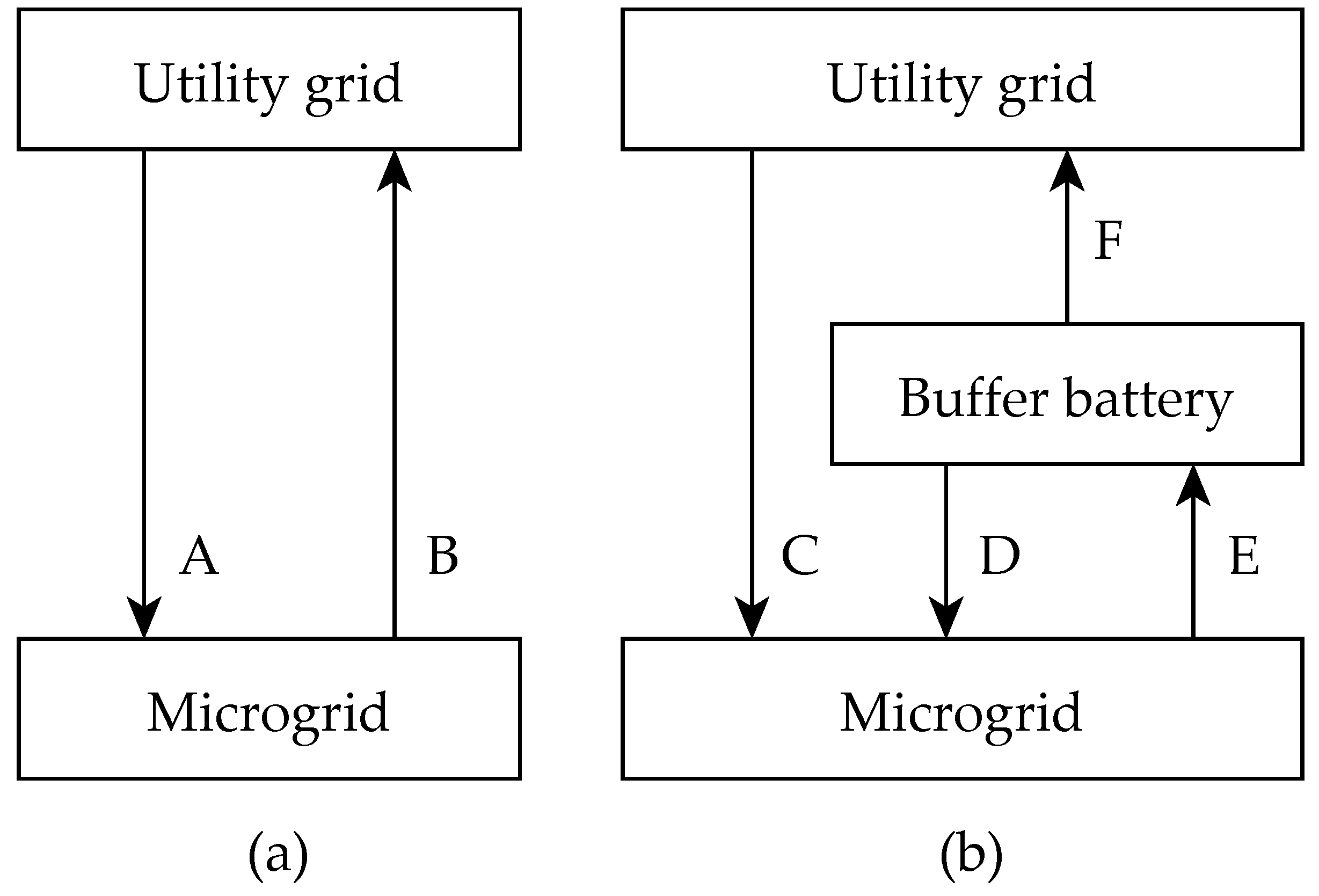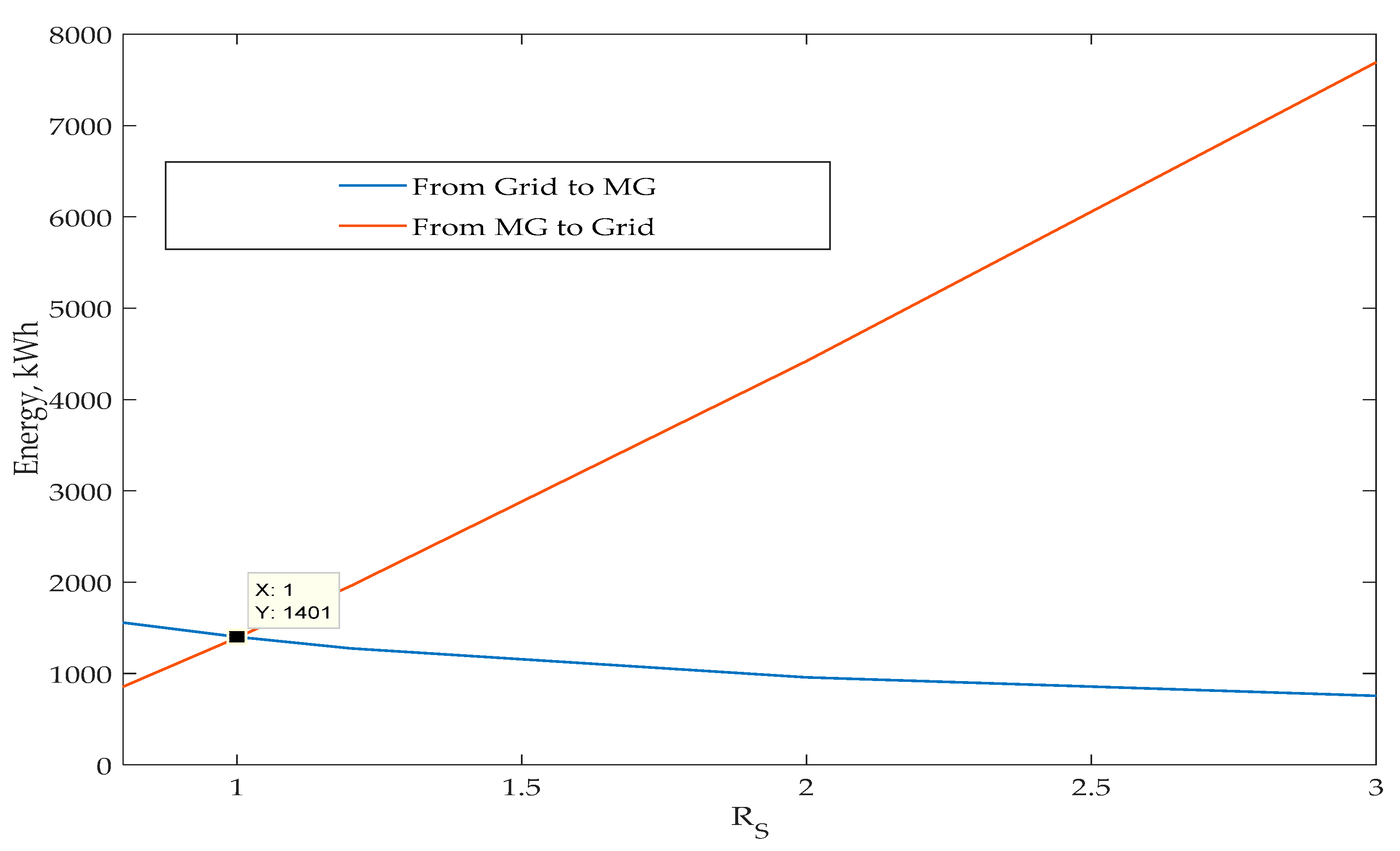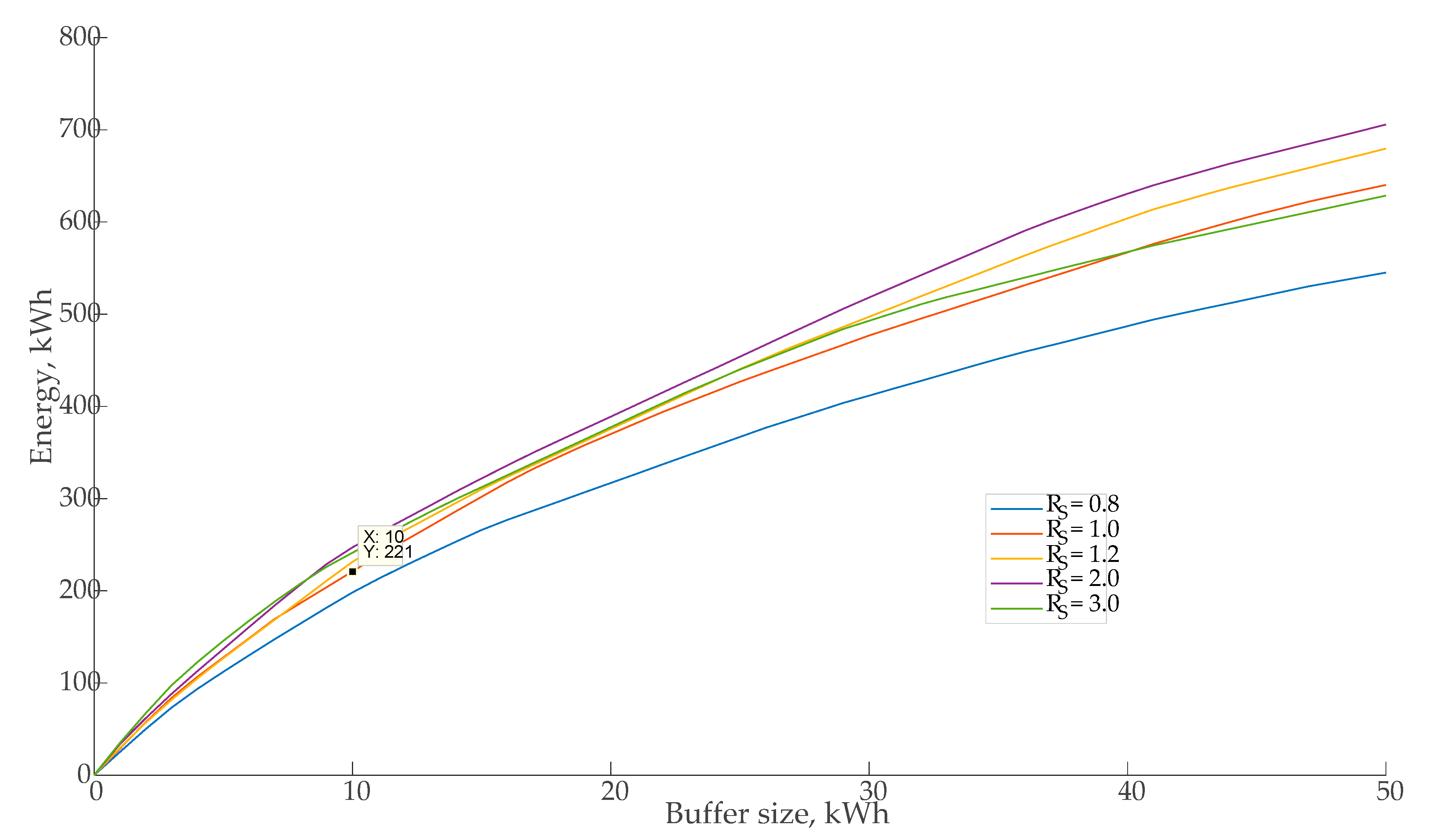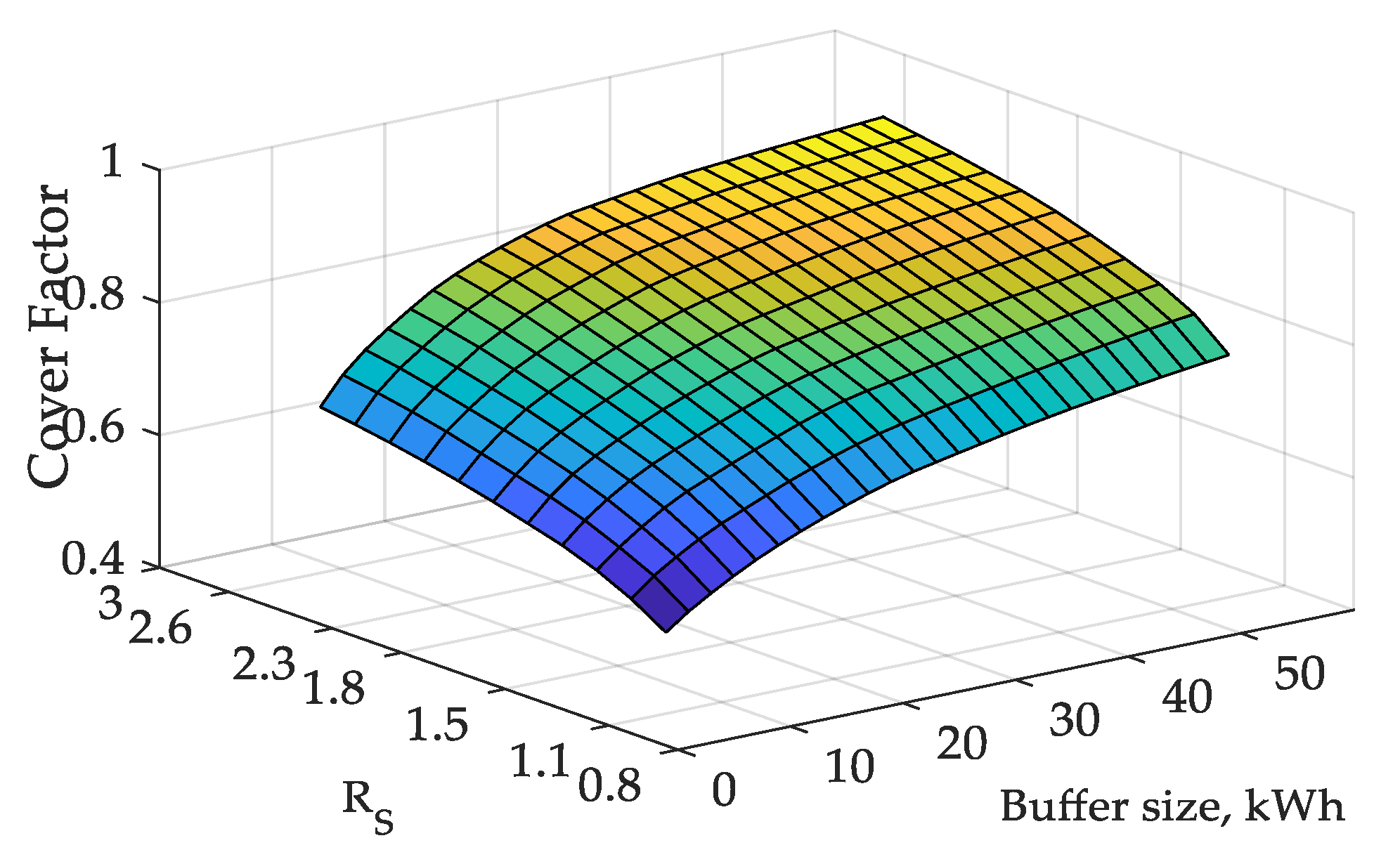Simulation of Energy Exchange between Single Prosumer Residential Building and Utility Grid
Abstract
1. Introduction
2. System Setup
3. Input Data
4. Simulation Model
- X1: is the output energy of wind generator in the current interval.
- X2: is the energy stored in a battery in the current interval.
- Z1: is the energy needed for NS consumption in the current interval.
- Z2: is the energy needed for hot water equipment in the current interval.
- (1)
- Next time interval is opened. Main action—the rest of the energies from previous intervals is transferred to the current one.
- (2)
- WG output X1 first satisfies NS loads Z1.
- (3)
- If X1 > Z1, the quantity X1–Z1 forwarded to WH. Steps 4 and 5 are skipped.
- (4)
- If X1 < Z1, the quantity Z1–X1 is taken from the battery, if possible, i.e., if Z1–X1 < X2. Otherwise, missing energy comes from UG.
- (5)
- Energy Z2 is taken from a battery or UG.
- (6)
- Energy movements saved.
- YD is the demand cover factor.
- W1 is the total annual amount of energy produced by WG, which is directly consumed by NS devices needs.
- W2 is the total annual amount of energy produced by WG, which is used with hot water consumption from WH.
- W3 is the total annual amount of energy produced by WG, which is used for NS consumption from the battery during the year. If the WG is unable to supply directly to NS load, the missing energy will be taken from the battery.
- W4 is the total annual amount of energy flowing back from BB to MG. This is if there is not enough power in the battery and WH, then the energy is taken from BB. This is new in this paper. The flow is depicted as Arrow D in Figure 1b and is decisive for finding the new demand cover factor value YD. If there is not enough energy in BB, it is taken directly from UG Arrow C on Figure 1b.
- Wtotal is the total annual amount of energy consumed for water heating and non-shiftable load, in other words, the total energy consumption of the entire household.
5. Results and Discussions
6. Conclusions
Author Contributions
Funding
Acknowledgments
Conflicts of Interest
References
- Energy Efficiency Directive. Available online: https://ec.europa.eu/energy/topics/energy-efficiency/targets-directive-and-rules/energy-efficiency-directive_en strategy (accessed on 10 January 2021).
- Naval, N.; Sánchez, R.; Yusta, J.M. A virtual power plant optimal dispatch model with large and small-scale distributed renewable generation. Renew. Energy 2020, 151, 57–69. [Google Scholar] [CrossRef]
- Annuk, A.; Jõgi, E.; Hovi, M.; Märss, M.; Uiga, J.; Hõimoja, H.; Peets, T.; Kalder, J.; Algirdas, J.; Allik, A. Increasing self electricity consumption by using double water heating tanks for residential net zero energy buildings. In Proceedings of the 6th International Conference on Renewable Energy Research and Application (ICRERA), San Diego, CA, USA, 5–8 December 2017; Volume 6, pp. 106–110. [Google Scholar] [CrossRef]
- Chub, A.; Zdanowski, M.; Blinov, A.; Rabkowski, J. Evaluation of GaN HEMTs for high-voltage stage of isolated DC-DC converters. In Proceedings of the 10th International Conference on Compatibility, Power Electronics and Power Engineering (CPE-POWERENG), Bydgoszcz, Poland, 29 June–1 July 2016; pp. 375–379. [Google Scholar] [CrossRef]
- Blinov, A.; Chub, A.; Vinnikov, D.; Rang, T. Feasibility study of Si and SiC MOSFETs in high-gain DC/DC converter for renewable energy applications. In Proceedings of the IECON 2013—39th Annual Conference of the IEEE Industrial Electronics Society, Vienna, Austria, 10–14 November 2013; pp. 5975–5978. [Google Scholar] [CrossRef]
- Lepa, J.; Annuk, A.; Kokin, E.; Põder, V.; Jürjenson, K. Energy production and consumption charts in energy system. Oil Shale 2009, 26, 309–318. [Google Scholar] [CrossRef]
- Zemug, L.; Su, S.; Yunning, Z.; Xiaolomg, J.; Houhe, C.; Yujiang, R. Energy management strategy of active distribution network with integrated distributed wind power and smart buildings. IET Renew. Power Gener. 2020, 14, 2255–2267. [Google Scholar] [CrossRef]
- DeCicco, M.; Liu, D.Y.; Heo, J.; Krishnan, R.; Kurthen, A.; Wang, L. Carbon balance effects of U.S. biofuel production and use. Clim. Change 2016, 138, 667–680. [Google Scholar] [CrossRef]
- Okok, M.O.; Ruchathi, G.; Oromat, E. Expanding access to clean energy in developing countries: The role of off-grid mini hydro power projects in Kenya. Int. J. Renew. Energy Res. 2019, 9, 1571–1577. [Google Scholar]
- Hadiyanto, D.; Purwanto, Y.A.; Noorachmat, B.P.; Sapei, A. An indicator and evaluation criteria for off-grid micro-hydro power sustainability assessment. Int. J. Renew. Energy Res. 2019, 9, 1–15. [Google Scholar]
- Zoss, T.; Karklina, I.; Blumberga, D. Power to gas and pumped hydro storage potential in Latvia. Energy Procedia 2016, 95, 528–535. [Google Scholar] [CrossRef]
- Kesgin, M.G.; Han, P.; Taran, N.; Ionel, D.M. Overview of flywheel systems for renewable energy storage with a design study for high-speed axial-flux permanent-magnet machines. In Proceedings of the 8th International Conference of Renewable Energy Research and Applications (ICRERA) 2019, Brasov, Romania, 3–6 November 2019; pp. 1026–1031. [Google Scholar] [CrossRef]
- Rehman, Z.; Mahmood, A.; Razaq, S.; Wamiq, A.; Naeem, U.; Shehzad, K. Prosumer based energy management and sharing in smart grid. Renew. Sustain. Energy Rev. 2018, 82, 1675–1684. [Google Scholar] [CrossRef]
- Jie, C.; Bu, Z.; Wang, Y.; Yang, H.; Jiang, J.; Li, H.-J. Detecting prosumer-community groups in smart grids from the multiagent perspective. IEEE Trans. Syst. Man Cybern. Syst. PP 2019, 99, 1–13. [Google Scholar] [CrossRef]
- Bautista-Villalon, M.; Gutirerrez-Villalobos, J.; Rivas-Araiza, E.A. IoT-based system to monitor and control household lighting and appliance power consumption and water demand. In Proceedings of the 7th International Conference of Renewable Energy Research and Applications (ICRERA) 2018, Paris, France, 14–17 October 2018; pp. 785–790. [Google Scholar]
- Blinov, A.; Vinnikov, D.; Husev, O.; Chub, A. Experimental analysis of wide input voltage range qZS-derived push-pull DC/DC converter for PMSG-based wind turbines. In Proceedings of the PCIM Europe, Nuremberg, Germany, 14–16 May 2013; pp. 1435–1444. [Google Scholar]
- Sambaiah, K.S. A review on optimal allocation and sizing techniques for DG in distribution systems. Int. J. Renew. Energy Res. 2018, 8, 1236–1256. [Google Scholar]
- Vanhoudt, D.; Geysen, B.; Claessens, F.; Leemans, L.; Jespers, L.; Bael, J.B. An actively controlled residential heat pump: Potential on peak shaving and maximization of self-consumption of renewable energy. Renew. Energy 2014, 63, 531–543. [Google Scholar] [CrossRef]
- Annuk, A.; Jõgi, E.; Lill, H.; Kalder, J.; Hovi, M.; Pihlap, H.; Härm, M.; Allik, A. Augmentation of self-consumption of electricity by using boilers and batteries for residential buildings. In Proceedings of the 7th International Conference of Renewable Energy Research and Applications (ICRERA), Paris, France, 14–17 October 2018; Volume 7, pp. 256–260. [Google Scholar] [CrossRef]
- Budes, E.E.B.; Ochoa, G.V.; Obregon, L.G.; Arango-Manrique, A.A.; Alvarez, J.R.N. Energy, economic, and environmental evaluation of a proposed solar-wind power on-grid system using HOMER Pro®: A case study in Colombia. Energies 2020, 13, 1662. [Google Scholar] [CrossRef]
- Katsaprakakis, D.A.; Zidianakis, G.; Yiannakoudakis, Y.; Manioudakis, E.; Dakanali, I.; Kanouras, S. Working on buildings’ energy performance upgrade in mediterranean climate. Energies 2020, 13, 2159. [Google Scholar] [CrossRef]
- Hossain, E.; Zawad, M.; Rakibul, K.H.; Islam, K.H.R.; Akash, M.Q. Design a novel controller for stability analysis of microgrid by managing controllable load using load shaving and load shifting techniques; and optimizing cost analysis for energy storage system. Int. J. Renew. Energy Res. 2016, 6, 772–786. [Google Scholar]
- Eltamaly, A.M.; Mohamed, M.A.; Alolah, A.I. A novel smart grid theory for optimal sizing of hybrid renewable energy systems. Sol. Energy 2016, 124, 26–38. [Google Scholar] [CrossRef]
- Hassanzadeh, M.N.; Fotuhi-Firuzabad, M.; Safdarian, A. Wind energy penetration with load shifting from the system well-being viewpoint. Int. J. Renew. Energy Res. 2017, 7, 977–987. [Google Scholar]
- Duerr, S.; Ababei, C.; Ionel, D.M. Load balancing with energy storage systems based on co-simulation of multiple smart buildings and distribution networks. In Proceedings of the 8th International Conference on Renewable Energy Research and Applications (ICRERA) 2017, San Diego, CA, USA, 5–8 December 2017; Volume 5, pp. 175–180. [Google Scholar]
- Jonaitis, A.; Miliute, R.; Deveikis, T. Dynamic model of wind power balancing in hybrid power system. Turk. J. Electr. Eng. Comput. Sci. 2017, 25, 222–234. [Google Scholar] [CrossRef]
- Bashir, A.A.; Kasmaei, M.P.; Safdarian, A.; Lehtonen, M. Matching of local load with on-site PV production in a grid-connected residential building. Energies 2018, 11, 2409. [Google Scholar] [CrossRef]
- Degefa, M.Z.; Lehtonen, M.; McCulloch, M.; Nixon, K. Real-time matching of local generation and demand: The use of high resolution load modeling. In Proceedings of the IEEE PES Innovative Smart Grid Technologies Conference Europe, Ljubljana, Slovenia, 9–12 October 2016. [Google Scholar]
- Hauer, I.; Balischewski, S.; Ziegler, C. Design and operation strategy for multi-use application of battery energy storage in wind farms. J. Energy Storage 2020, 32, 101572. [Google Scholar] [CrossRef]
- Li, X.; Lim, M.K.; Ni, D.; Zhong, B.; Xiao, Z.; Hao, H. Sustainability or continuous damage: A behaviour study of prosumers´ electricity cinsumption after installing household disreibuted energy resources. J. Clean. Prod. 2020, 264, 121471. [Google Scholar] [CrossRef]
- Rogeau, A.; Barbier, T.; Girard, R.; Kong, N. Evoluotion of electrical distribution grid sizing considering self-consunption of local renewable producton. In Proceedings of the 24th International Confeence & Exhibition on Electricity Distribution (CIRED), Glasgow, UK, 12–15 June 2017; pp. 1–5. [Google Scholar]
- Dancker, J.; Götze, J.; Schultz, E.; Könneke, N.; Beyrau, F.; Wolter, M. Optimal design and operation of a CHP based district heating system including a heat storage and electrode boiler to increase self-consumption. In Proceedings of the 2019 IEEE Inovative Smart Grid Technologies Conference—Latin America (ISGT Latin America), Gramado, Brazil, 15–18 September 2019. [Google Scholar] [CrossRef]
- Kroposki, B.; Basso, T.; DeBlasio, R. Microgrid standards and technologies. In Proceedings of the IEEE Power and Energy Society 2008 General Meeting: Conversion and Delivery of Electrical Energy in the 21st Century, PES, Pittsburg, PA, USA, 20–24 July 2008. [Google Scholar] [CrossRef]
- Geidl, M.; Koeppel, G.; Favre-Perrod, P.; Klöckl, B.; Andresson, G.; Fröhlich, K. Energy hubs for the future. IEEE Power Energy Mag. 2007, 5, 24–30. [Google Scholar] [CrossRef]
- TUGE 10 Technical Data, 10 kW. Tuge Energia Ltd., Paldiski, Estonia, 2020; pp. 4–6. Available online: http://www.tuge.ee/products/tuge10 (accessed on 10 January 2021).
- Volker, S.; Kistemann, T. Field testing hot water temperature reduction as an energy-saving measure—Does the Legionella presence change in a clinic’s plumbing system? Environ. Technol. 2015, 36, 2138–2147. [Google Scholar] [CrossRef]
- Annuk, A.; Hovi, M.; Kalder, J.; Märss, M. Consumption and Wind Production Time Series Data. Estonian University of Life Sciences: Tartu, Estonia, 2020. Available online: https://doi.org/10.15159/eds.dt.20.02 (accessed on 10 January 2021).
- Baetens, R.; De Coninck, R.; Roy, J.V.; Verbuggen, B.; Driese, J.; Helsen, L.; Saelens, D. Assessing electrical bottlenecks at feeder level for residential net zero-energy buildings by integrated systemsimulation. Appl. Energy 2012, 96, 74–83. [Google Scholar] [CrossRef]
- Sperstad, I.B.; Korpås, M. Energy storage scheduling in distribution systems considering wind and photovoltaic generation uncertainties. Energies 2019, 12, 1231. [Google Scholar] [CrossRef]
- Hossein, S.M.; Carli, R. A residential demand-side management strategy under nonlinear pricing based on robust model predictive control. In Proceedings of the 2019 IEEE International Conference on Systems, Man and Cybernetics (SMC), Bari, Italy, 6–9 October 2019; pp. 3243–3248. [Google Scholar] [CrossRef]
- Annuk, A.; Hovi, M.; Kalder, J.; Kabanen, T.; Ilves, R.; Märss, M.; Martinkauppi, B.; Miidla, P. Methods for increasing shares of self-consumption in small PV solar energy applications. In Proceedings of the 9th International Conference on Renewable Energy Research and Applications (ICRERA) 2020, Glasgow, UK, 26–29 September 2020; Volume 5, pp. 184–188. [Google Scholar] [CrossRef]
- Shi, R.; Li, S.; Zhang, P.; Lee, K. Integration of renewable energy sources and electric vehicles in V2G network with adjustable robust optimization. Renew. Energy 2020, 153, 1067–1080. [Google Scholar] [CrossRef]









Publisher’s Note: MDPI stays neutral with regard to jurisdictional claims in published maps and institutional affiliations. |
© 2021 by the authors. Licensee MDPI, Basel, Switzerland. This article is an open access article distributed under the terms and conditions of the Creative Commons Attribution (CC BY) license (http://creativecommons.org/licenses/by/4.0/).
Share and Cite
Annuk, A.; Yaïci, W.; Lehtonen, M.; Ilves, R.; Kabanen, T.; Miidla, P. Simulation of Energy Exchange between Single Prosumer Residential Building and Utility Grid. Energies 2021, 14, 1553. https://doi.org/10.3390/en14061553
Annuk A, Yaïci W, Lehtonen M, Ilves R, Kabanen T, Miidla P. Simulation of Energy Exchange between Single Prosumer Residential Building and Utility Grid. Energies. 2021; 14(6):1553. https://doi.org/10.3390/en14061553
Chicago/Turabian StyleAnnuk, Andres, Wahiba Yaïci, Matti Lehtonen, Risto Ilves, Toivo Kabanen, and Peep Miidla. 2021. "Simulation of Energy Exchange between Single Prosumer Residential Building and Utility Grid" Energies 14, no. 6: 1553. https://doi.org/10.3390/en14061553
APA StyleAnnuk, A., Yaïci, W., Lehtonen, M., Ilves, R., Kabanen, T., & Miidla, P. (2021). Simulation of Energy Exchange between Single Prosumer Residential Building and Utility Grid. Energies, 14(6), 1553. https://doi.org/10.3390/en14061553







